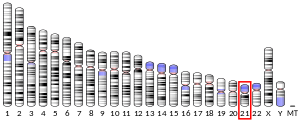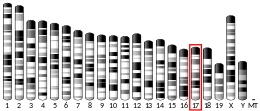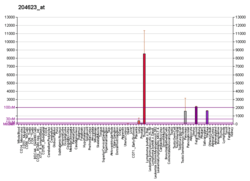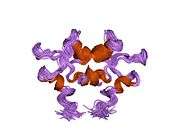Trefoil factor 3
Trefoil factor 3 is a protein that in humans is encoded by the TFF3 gene.[5][6][7]
| TFF3 | |||||||||||||||||||||||||
|---|---|---|---|---|---|---|---|---|---|---|---|---|---|---|---|---|---|---|---|---|---|---|---|---|---|
 | |||||||||||||||||||||||||
| |||||||||||||||||||||||||
| Identifiers | |||||||||||||||||||||||||
| Aliases | TFF3, ITF, P1B, TFI, trefoil factor 3 | ||||||||||||||||||||||||
| External IDs | OMIM: 600633 MGI: 104638 HomoloGene: 2427 GeneCards: TFF3 | ||||||||||||||||||||||||
| |||||||||||||||||||||||||
| |||||||||||||||||||||||||
| |||||||||||||||||||||||||
| |||||||||||||||||||||||||
| Orthologs | |||||||||||||||||||||||||
| Species | Human | Mouse | |||||||||||||||||||||||
| Entrez | |||||||||||||||||||||||||
| Ensembl | |||||||||||||||||||||||||
| UniProt | |||||||||||||||||||||||||
| RefSeq (mRNA) | |||||||||||||||||||||||||
| RefSeq (protein) | |||||||||||||||||||||||||
| Location (UCSC) | Chr 21: 42.31 – 42.32 Mb | Chr 17: 31.13 – 31.13 Mb | |||||||||||||||||||||||
| PubMed search | [3] | [4] | |||||||||||||||||||||||
| Wikidata | |||||||||||||||||||||||||
| |||||||||||||||||||||||||
Function
Members of the trefoil family are characterized by having at least one copy of the trefoil motif, a 40-amino acid domain that contains three conserved disulfide bonds. They are stable secretory proteins expressed in gastrointestinal mucosa. Their functions are diverse, including protection of the mucosa, thickening of the mucus, and increasing epithelial healing rates. This gene is a marker of columnar epithelium and is expressed in a variety of tissues including goblet cells of the intestines and colon. This gene and two other related trefoil family member genes are found in a cluster on chromosome 21.[7]
Glycan binding
All three human trefoil factors are lectins that interact specifically with the disaccharide GlcNAc-α-1,4-Gal.[8] This disaccharide is an unusual glycotope that is only known to exist on the large, heavily glycosylated, mucins in the mucosa. By cross-linking mucins through the bivalent binding of this glycotope, the trefoil factors are then able to reversible modulate the thickness and viscosity of the mucus.[8]
In breast milk
Trefoil factors (TFF) are secretory products of mucin producing cells. They play a key role in the maintenance of the surface integrity of oral mucosa and enhance healing of the gastrointestinal mucosa by a process called restitution. TFF comprises the gastric peptides (TFF1), spasmolytic peptide (TFF2), and the intestinal trefoil factor (TFF3, this protein). They have an important and necessary role in epithelial restitution within the gastrointestinal tract. Significant amounts of TFF are present in human milk. Evidence has been presented that TFF3 isolated from milk strongly correlates with downregulation of IL-6 and IL-8 in human intestinal epithelial cells. On the other hand, TFF3 activated the epithelial cells in culture to produce beta defensins 2 (hBD2) and beta defensins 4 (hBD4). These findings suggest that TFF can activate intestinal epithelial cells and could actively participate in the immune system of breastfed babies by inducing the production of peptides related to innate defence, such as defensins.[9]
Activation of PAR-2 receptors
Two main mechanisms have been described for the activation of PAR-2: (A) by specific cleavage that unmask the receptor-activating peptide sequence present in the extracellular N-terminal domain of each PAR, leading to cell signaling via interaction of the exposed tethered ligand with the body of the receptor itself; and (B) by synthetic peptides, such as SLIGKV, that bind to the receptor, mimicking the actions of agonist proteases.[10] During lactation, TFF3 secreted in human milk may activate intestinal epithelial cells through PAR-2 receptors, which in turn induces hBD2 and hBD4 expression and cytokine regulation.[10]
Clinical significance
Using TFF3 as a marker of columnar epithelium, a process using an ingestible oesophageal sampling device (Cytosponge) coupled with immunocytochemistry for trefoil factor 3 to improve the accuracy and acceptability of the detection/screening of Barrett's oesophagus has been developed.[11] However the clinical utility of such a test may be limited by frequent staining of TFF3 in gastric cardia and subsequent risk of false positives.[12]
References
- GRCh38: Ensembl release 89: ENSG00000160180 - Ensembl, May 2017
- GRCm38: Ensembl release 89: ENSMUSG00000024029 - Ensembl, May 2017
- "Human PubMed Reference:". National Center for Biotechnology Information, U.S. National Library of Medicine.
- "Mouse PubMed Reference:". National Center for Biotechnology Information, U.S. National Library of Medicine.
- Thim L, Woldike HF, Nielsen PF, Christensen M, Lynch-Devaney K, Podolsky DK (May 1995). "Characterization of human and rat intestinal trefoil factor produced in yeast". Biochemistry. 34 (14): 4757–64. doi:10.1021/bi00014a033. PMID 7718582.
- Gott P, Beck S, Machado JC, Carneiro F, Schmitt H, Blin N (May 1997). "Human trefoil peptides: genomic structure in 21q22.3 and coordinated expression". Eur J Hum Genet. 4 (6): 308–15. doi:10.1159/000472224. PMID 9043862.
- "Entrez Gene: TFF3 trefoil factor 3 (intestinal)".
- Järvå MA, Lingford JP, John A, Soler NM, Scott NE, Goddard-Borger ED (May 2020). "Trefoil factors share a lectin activity that defines their role in mucus". Nature Communications. 11 (1): 2265. doi:10.1038/s41467-020-16223-7. PMID 32404934.
- Barrera GJ, Sanchez G, Gonzalez JE (November 2012). "Trefoil factor 3 isolated from human breast milk downregulates cytokines (IL8 and IL6) and promotes human beta defensin (hBD2 and hBD4) expression in intestinal epithelial cells HT-29". Bosn J Basic Med Sci. 12 (4): 256–64. doi:10.17305/bjbms.2012.2448. PMC 4362502. PMID 23198942.
- Barrera GJ, Tortolero GS (2016). "Trefoil factor 3 (TFF3) from human breast milk activates PAR-2 receptors, of the intestinal epithelial cells HT-29, regulating cytokines and defensins". Bratislavské LekáRske Listy. 117 (6): 332–9. doi:10.4149/bll_2016_066. PMID 27546365.
- Kadri SR, Lao-Sirieix P, O'Donovan M, Debiram I, Das M, Blazeby JM, Emery J, Boussioutas A, Morris H, Walter FM, Pharoah P, Hardwick RH, Fitzgerald RC (2010). "Acceptability and accuracy of a non-endoscopic screening test for Barrett's oesophagus in primary care: cohort study". BMJ. 341: c4372. doi:10.1136/bmj.c4372. PMC 2938899. PMID 20833740.
- Peitz U, Kouznetsova I, Wex T, Gebert I, Vieth M, Roessner A, Hoffmann W, Malfertheiner P (2004). "TFF3 expression at the esophagogastric junction is increased in gastro-esophageal reflux disease (GERD)". Peptides. 25 (5): 771–7. doi:10.1016/j.peptides.2004.01.018. PMID 15177871.
Further reading
- Barrera GJ, Sanchez G, Gonzalez JE (2012). "Trefoil factor 3 isolated from human breast milk downregulates cytokines (IL8 and IL6) and promotes human beta defensin (hBD2 and hBD4) expression in intestinal epithelial cells HT-29". Bosn J Basic Med Sci. 12 (4): 256–64. doi:10.17305/bjbms.2012.2448. PMC 4362502. PMID 23198942.
- Hoffmann W, Jagla W, Wiede A (2001). "Molecular medicine of TFF-peptides: from gut to brain". Histol. Histopathol. 16 (1): 319–34. PMID 11193208.
- Hoffmann W, Jagla W (2002). "Cell type specific expression of secretory TFF peptides: colocalization with mucins and synthesis in the brain". Int. Rev. Cytol. International Review of Cytology. 213: 147–81. doi:10.1016/S0074-7696(02)13014-2. ISBN 978-0-12-364617-0. PMID 11837892.
- Langer G, Jagla W, Behrens-Baumann W, et al. (2003). "Ocular TFF-peptides: new mucus-associated secretory products of conjunctival goblet cells". Adv. Exp. Med. Biol. 506 (Pt A): 313–6. doi:10.1007/978-1-4615-0717-8_44. PMID 12613926.
- Seib T, Dooley S, Welter C (1995). "Characterization of the genomic structure and the promoter region of the human intestinal trefoil factor". Biochem. Biophys. Res. Commun. 214 (1): 195–9. doi:10.1006/bbrc.1995.2274. PMID 7669039.
- Podolsky DK, Gerken G, Eyking A, Cario E (2009). "Colitis-associated variant of TLR2 causes impaired mucosal repair because of TFF3 deficiency". Gastroenterology. 137 (1): 209–20. doi:10.1053/j.gastro.2009.03.007. PMC 2812790. PMID 19303021.
- Hauser F, Poulsom R, Chinery R, et al. (1993). "hP1.B, a human P-domain peptide homologous with rat intestinal trefoil factor, is expressed also in the ulcer-associated cell lineage and the uterus". Proc. Natl. Acad. Sci. U.S.A. 90 (15): 6961–5. Bibcode:1993PNAS...90.6961H. doi:10.1073/pnas.90.15.6961. PMC 47055. PMID 8346203.
- Podolsky DK, Lynch-Devaney K, Stow JL, et al. (1993). "Identification of human intestinal trefoil factor. Goblet cell-specific expression of a peptide targeted for apical secretion". J. Biol. Chem. 268 (9): 6694–702. PMID 8454642.
- Schmitt H, Wundrack I, Beck S, et al. (1996). "A third P-domain peptide gene (TFF3), human intestinal trefoil factor, maps to 21q22.3". Cytogenet. Cell Genet. 72 (4): 299–302. doi:10.1159/000134208. PMID 8641134.
- Chinery R, Williamson J, Poulsom R (1997). "The gene encoding human intestinal trefoil factor (TFF3) is located on chromosome 21q22.3 clustered with other members of the trefoil peptide family". Genomics. 32 (2): 281–4. doi:10.1006/geno.1996.0117. PMID 8833157.
- Probst JC, Zetzsche T, Weber M, et al. (1997). "Human intestinal trefoil factor is expressed in human hypothalamus and pituitary: evidence for a novel neuropeptide". FASEB J. 10 (13): 1518–23. doi:10.1096/fasebj.10.13.8940297. PMID 8940297.
- Seib T, Blin N, Hilgert K, et al. (1997). "The three human trefoil genes TFF1, TFF2, and TFF3 are located within a region of 55 kb on chromosome 21q22.3". Genomics. 40 (1): 200–2. doi:10.1006/geno.1996.4511. PMID 9070946.
- Tan XD, Liu QP, Hsueh W, et al. (1999). "Intestinal trefoil factor binds to intestinal epithelial cells and induces nitric oxide production: priming and enhancing effects of mucin". Biochem. J. 338 (3): 745–51. doi:10.1042/0264-6021:3380745. PMC 1220112. PMID 10051448.
- Hattori M, Fujiyama A, Taylor TD, et al. (2000). "The DNA sequence of human chromosome 21". Nature. 405 (6784): 311–9. Bibcode:2000Natur.405..311H. doi:10.1038/35012518. PMID 10830953.
- Berry A, Scott HS, Kudoh J, et al. (2001). "Refined localization of autosomal recessive nonsyndromic deafness DFNB10 locus using 34 novel microsatellite markers, genomic structure, and exclusion of six known genes in the region". Genomics. 68 (1): 22–9. doi:10.1006/geno.2000.6253. PMID 10950923.
- Wiede A, Hinz M, Canzler E, et al. (2001). "Synthesis and localization of the mucin-associated TFF-peptides in the human uterus". Cell Tissue Res. 303 (1): 109–15. doi:10.1007/s004410000297. PMID 11235998.
- Yamachika T, Werther JL, Bodian C, et al. (2002). "Intestinal trefoil factor: a marker of poor prognosis in gastric carcinoma". Clin. Cancer Res. 8 (5): 1092–9. PMID 12006524.
- Kimura Y, Leung PS, Kenny TP, et al. (2002). "Differential expression of intestinal trefoil factor in biliary epithelial cells of primary biliary cirrhosis". Hepatology. 36 (5): 1227–35. doi:10.1053/jhep.2002.36157. PMID 12395334.






